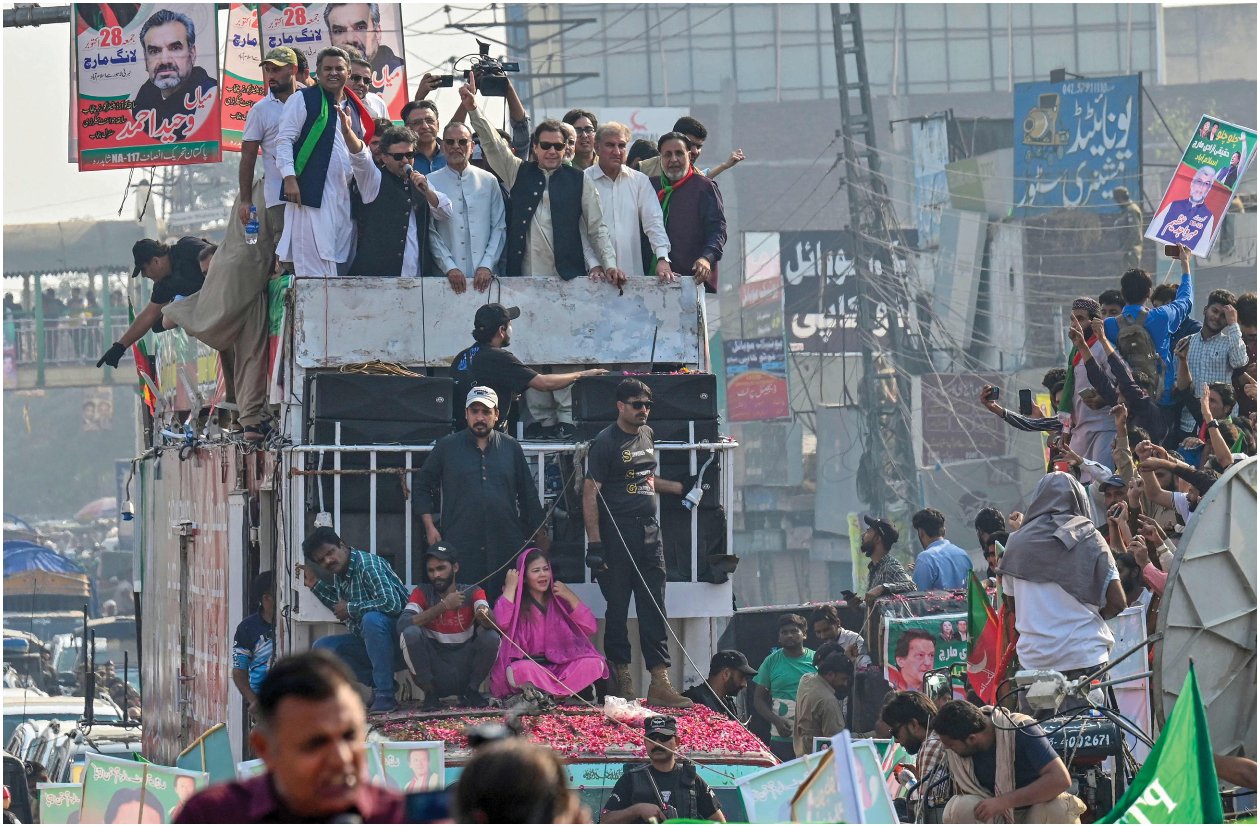
One Step Forward, Two Back
Imran Khan’s march remains mired in maybes, must dos, and what ifs — as is the govt’s response to it
In the last six months, Imran Khan, displaying enviable energy at the age of 71, has held more than 60 public gatherings all over the country and given dozens of interviews to television channels and social media platforms, taking his narrative to the grassroots. Khan’s strategy to keep his supporters mobilised has multiple advantages for him. Despite a ban imposed on television channels broadcasting his live addresses, he remains in the limelight courtesy social media which has a far greater impact than imagined. In the by-elections last month, he won seven out of eight national seats against the candidates of the combined opposition parties. This although the electorate was fully aware of the fact that he would not be present in Parliament. In a way then, the people seemed to have cast a protest vote against the sitting government and the entire set-up, rejecting the regime-change exercise and expressing their confidence in Khan’s narrative.
In the so-called long march, commencing on October 27, the PTI took the G. T. Road route from Lahore to Rawalpindi, penetrating what was hitherto a PML-N stronghold. With sizeable crowds greeting and cheering Khan in each city along the way, it is clear that he has mustered a large following — especially comprising the youth — in the heart of the Sharifs’ constituency. Many traditional supporters of the ruling PML-N are disenchanted with their erstwhile party owing to the unprecedented price-hike and closure of factories in the industrial regions of central Punjab since Shehbaz Sharif took charge as Prime Minister in April.
Interior Minister Rana Sanaullah himself admitted in a television interview that the people were angry with the government over the mounting inflation and the shutting down of businesses. Under Imran Khan’s onslaught and realising the waning support for the PML-N, Prime Minister Shehbaz Sharif recently rushed to take certain populist measures, among them the announcement of several financial benefits for farmers, including additional loans worth Rs 400 billion and some relief in the electricity cost for tubewells and fertilisers.
Imran Khan’s stated objective for initiating his protest rally is to force the government to announce snap polls. However, Nawaz Sharif has given it a twist, and claims that Imran Khan’s objective is not ‘revolution,’ but getting his own nominee appointed as the next army chief. Last week, Maryam Nawaz also expressed the same view, saying Imran Khan intended to disrupt and delay the process of the army chief’s appointment.
Khan’s mobilisation of his supporters has created an atmosphere in which the army chief assuming office on November 30, will likely want to shed the baggage inherited from his predecessor and calm the political temperature in the country. If not through brute force, he will presumably like to find a means to bring the two sides on the table and make them agree to devise a way out from the continuing instability.
The murder of journalist Arshad Sharif in Kenya has complicated matters for the powers-that-be. It has put certain institutions on the defensive. The chances of using extra-constitutional means are slim, because it is hard to imagine that the US administration, whose influence in Pakistan’s internal matters cannot be denied, would back such measures given President Joe Biden’s policy of rules-based order. But there is a growing realisation: Khan’s visible popularity has sent a message to the outside world that he is the man who truly represents the people of this country and needs to be engaged.
As the PTI protest caravan progresses, Imran Khan’s tone has become increasingly aggressive. He has named two officers in key positions who he alleges are involved in arresting and torturing his colleagues and conveying threats to them. However, he admits that talks with the establishment are simultaneously continuing in the background. It is believed that Imran Khan has slowed the pace of his protest march and delayed its arrival in Islamabad by a week to allow the mediators concerned to reach a consensus before the marchers reach the federal capital. This is what makes the PML-N nervous. PML-N supporters are now openly contending that a section of the establishment supports Imran Khan. Commenting on the joint news conference of the Director General ISPR and Director General ISI, pro-PMLN analyst Najam Sethi said the presser was meant to convey a clear message to “Imrandooz” (a derogatory, insulting word he uses for IK’s supporters) within the establishment about the intention of the top leadership. Senior journalist Mohammad Malick corroborated this view and revealed in an interview that “An army officer told me the presser’s purpose was to end any ambiguity about the policy of the top leadership.” Meanwhile, the PML-N-PPP government is determined not to accept IK’s demand for early general elections. Shehbaz Sharif claims that Imran Khan sent him a message asking for talks on two issues: (a) the appointment the of new army chief with his consultation; (b) a date for early elections. Sharif says he rejected Khan’s demand for consulting him on the army chief’s appointment, but is willing to hold talks on the issue of elections.
A few days earlier, a couple of federal ministers belonging to the ruling PML-N, including Rana Sanaullah and Tanveer Hussain, had made public statements inviting Imran Khan for a dialogue with the government. Thereafter, it was in the air that representatives of the two sides had secretly met and held talks, but the negotiations broke down. After this, both sides hardened their positions. It is now perceived across the board that if the government bows down, it will create an impression of weakness, and if Imran Khan is seen talking to the government, the zeal and fervour of his supporters will diminish, harming his protest plans.
Nawaz Sharif has, however, taken a hard line against Imran Khan. In a recent statement, Nawaz Sharif advised his brother Prime Minister Shehbaz Sharif not to accept any demand made by Imran Khan, whom he declared a ‘fitna’ (a big mischief-maker). He has asked his brother to not even give Khan any face-saving opportunity to end his long march. Sharif’s tough posturing may just be a tactic, as even while he issues such instructions, Interior Minister Rana Sanaullah yet again offered the PTI talks aimed at resolving issues. Imran Khan, however, has refused to hold direct negotiations with the PDM government and said he was only willing to talk to their ‘handlers,’ a euphemism for the establishment.
Once in Islamabad, the PTI chief may review his policy. If the two sides sit across a table, both will have to show flexibility in their respective positions. It makes little difference for Imran Khan if general elections are held in March, or November next year. Voters do not change their loyalties in a short period of time. He can use the current opportunity to make the government agree to his long-held demand for the use of Electronic Voting Machines (EVMs) in the polls and making adequate arrangements for overseas Pakistanis to cast their votes. The coalition has vowed to complete the constitutional tenure of the present assemblies — ie. continue until August next year. Some of the coalition leaders such as Maulana Fazlur Rehman want the government to extend the term by one more year, invoking the emergency clause of the Constitution. The government parties believe they can ‘manage’ Imran Khan and suppress the popularity wave in his favour. They believe they can chip away at influential local notables from the PTI to weaken his electoral strength. Also, in the next federal budget the ruling coalition will have room to spend lavishly on politically motivated populist schemes, thus winning over public support. In order to tarnish Imran Khan’s reputation within state institutions, a propaganda campaign has already been unleashed dubbing Khan as an anarchist who wants to weaken the state, in particular the Pakistan Army.
The outcome of Imran Khan’s long march largely depends on the strength of the crowd he gathers in or around Islamabad and the duration of the sit-in. The government has deployed a strong contingent of assorted security forces to stop the protesters entering the city, but the protesters can block the entry and exit roads, laying siege to the capital, paralysing normal life. Some PTI leaders have also suggested that the sit-in should be staged in the neighbouring city of Rawalpindi, where the army headquarters are located. However, if the number of protesters remains below the critical point, say, a few thousands, it will not worry the federal government and can easily be dispersed. In this case, Khan will probably call off the protest after a few days of sitting-in.
Catch all the National Nerve News, Breaking News Event and Latest News Updates on The BOL News
Download The BOL News App to get the Daily News Update & Live News.





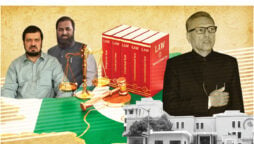
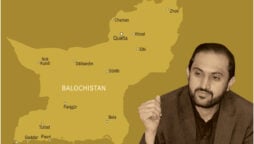
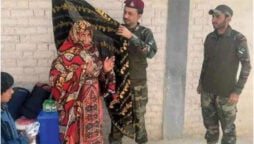
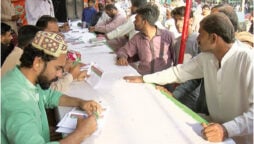
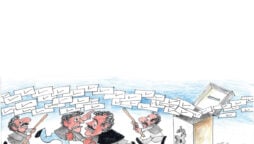
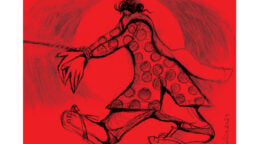

 Read the complete story text.
Read the complete story text. Listen to audio of the story.
Listen to audio of the story.